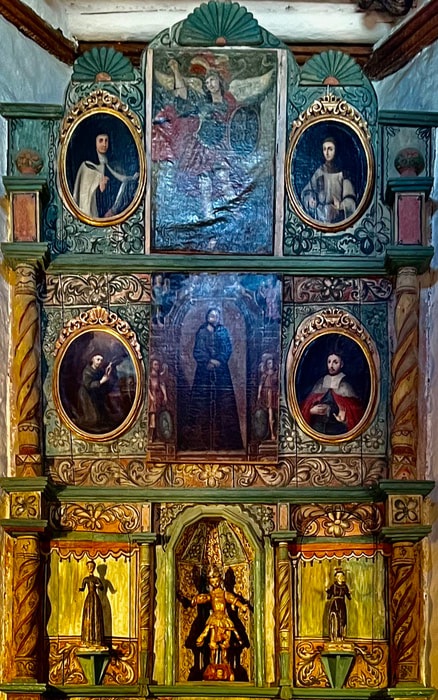|
By Miguel Pérez
Part 10 of a series No, I have not been canonized, not yet anyway. This website has not been recognized as a miracle yet. lol
But I've wanted to come here for many years, not only because this chapel has my name, but because San Miguel Chapel is considered the oldest church on the United States mainland! It was built by Mexican Tlaxcalan Indians and Spanish Franciscan padres at about the same time the City of Santa Fe was established, circa 1610. And it still celebrates Mass on the first Sunday of every month. |
|
Named after St. Michael the Archangel, the chapel first served as a place of worship for small groups of Tlaxcalan Indians and Spanish settlers and soldiers who had migrated from Tlaxcala province, Mexico, and lived in the area south of the Santa Fe River. The Chapel is located in the Barrio de "Analco" district, which means "the other side of the river."
Although severely damaged by feuds and rebellions, San Miguel was always rebuilt. The original church had a dirt floor and a mud-and-wood roof. But its very thick adobe walls always stood the test of time. In 1640, parts of the chapel were destroyed by Spanish soldiers, who had been feuding with Franciscan friars over Spanish mistreatment of the natives. Spanish governor Luis de Rosas, siding with the soldiers, expelled the Franciscans from Santa Fe. He had been forcing some natives to work for him and even sold some of them as slaves. |
To enlarge these images, click on them!
|
|
Yet, after an investigation of the conflict, De Rosas was removed from his position as the ninth Spanish governor of New Mexico. He was imprisoned and murdered by soldiers while in prison, and the Franciscans were allowed to return to rebuild San Miguel.
The chapel remained active for 40 more years, until the natives rebelled against the Spanish in what came to be known as the Pueblo Revolt of 1680. As the Spanish were driven out of the area, the chapel was set on fire, loosing the roof, ornaments and all except its adobe walls. "Everyone hiding in the chapel perished," according to church literature. "It was a concerted attack that drove the Spanish as far south as El Paso." |
|
Yet, 12 years later, in 1693, after the Spanish reconquered New Mexico, the new Spanish governor, Diego de Vargas, ordered the reconstructions of the church.
However, because of lack of wood and other building materials, the reconstruction took another 17 years to complete and San Miguel reopened in 1710. It has undergone significant structural remodeling, but the present building dates from 1710. |
|
In 1798, the City of Santa Fe paid for the reconstruction of chapel’s altar, which is covered by nine works or art. (See photos below). In 1872, a catastrophic storm brought down the bell tower, but it was rebuilt a few years later. And there have been many other renovations. San Miguel parishioners never give up — not when they know they are standing on a historic site.
"San Miguel still sits upon its original foundation over a Pueblo Indian dwelling," according to the brief history at the church altar. "It is located at the crossroads of the Old Santa Fe Trail, El Camino Real, and the Old Spanish Trail." That's quite an intersection! Heading east, the 870-mile Old Santa Fe Trail connected Santa Fe with Independence, Missouri; heading south, the 1,590-mile Camino Real connected Santa Fe with Mexico City; and heading west, the 700-mile Old Spanish Trail connected Santa Fe with Los Angeles. (See my Google map). |
|
It makes me feel like hitting the road! But since we are in the oldest church and the "oldest house" is across the street, where do you think I should go next? Stay tuned.
|
To read other parts of this ongoing series, click: EXPLORING NEW MEXICO



















